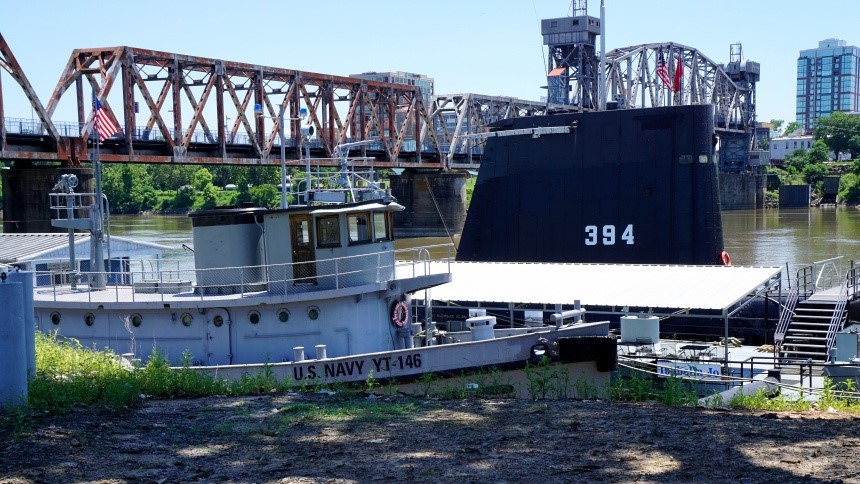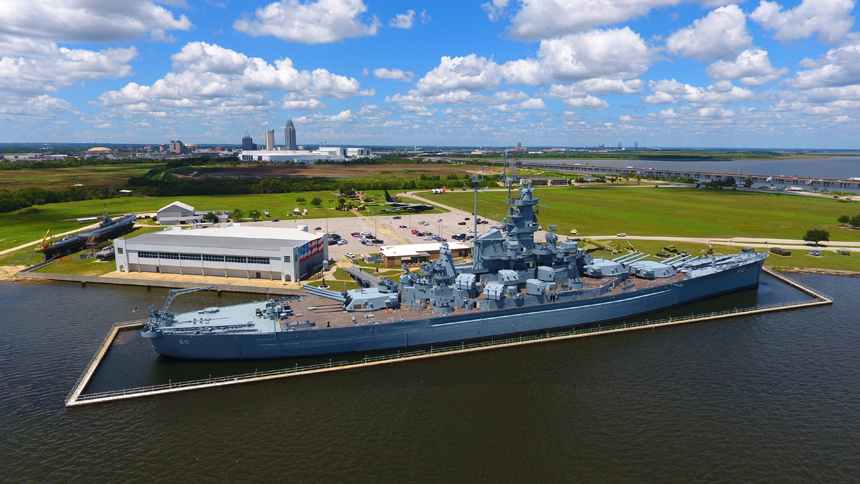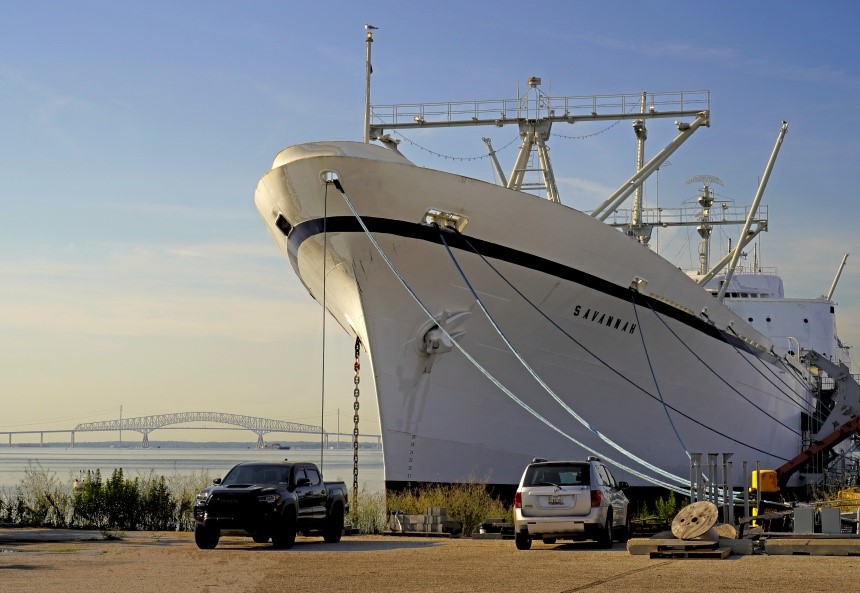If there’s navigable water nearby, chances are you’ll find a historic ship waiting to whistle you aboard. Big or small, these floating icons are lovingly maintained by enthusiasts who live and breathe America’s maritime legacy.
USS Razorback and USS Hoga
North Little Rock, Arkansas
“I know it looks scary,” says Scott Sudduth, coaxing me down the tube-like rear entry hatch. We are in the USS Razorback, a historic World War II submarine that served from Pearl Harbor to Vietnam and is now moored in North Little Rock, Arkansas.
“Don’t worry,” he laughs. “We’ve got Boy Scouts who do this all the time!”
It’s not so much scary down there as just plain dark. The sun outside is high in the sky, glaring off the Arkansas River and rendering everything below invisible. Still, I can just make out the tips of Sudduth’s outstretched fingers below, so down I go.
It’s a short hop to the floor from the ladder’s lowest rung. As my eyes grow accustomed to the low light, I realize I’m rubbing my elbows against a batch of torpedoes. Each of these babies was controlled with a guidance mechanism designed by, of all people, Hollywood actress Hedy Lamarr.
“Razorback used her torpedoes — she sank five Japanese ships,” says Sudduth, whose day job is as executive director of the North Little Rock Convention and Visitor’s Bureau, but who clearly loves his volunteer work as a Razorback docent.

In the back of a submarine there’s only one way to go: straight ahead. We pass outside the radio room and through the engine room, crammed tight with Razorback’s Pratt and Whitney diesel engines, which are still fired up once a month. The crew quarters consist of bunk beds, triple stacked and pressed up against the inside of the hull — enough to sleep half the crew of 70.
By the time we reach the tiny kitchen that served hundreds of meals every day, it’s clear sub duty has never been for everyone — and, just maybe, isn’t really for anyone.
Razorback — one of four submarines present in Tokyo Bay for the Japanese surrender in 1945 — is part of the Arkansas Inland Marine Museum, which also includes a legendary tugboat, the USS Hoga, which on the morning of December 7, 1941, was the first ship to respond to the attack on Pearl Harbor, pushing vessels out of harm’s way.

“This is the only Pearl Harbor ship still afloat,” says Sudduth. “These two ships bookend the Second World War. I don’t think there’s any other place where you can experience that.”
BEFORE YOU GO: On the Razorback’s website, read the digital version of the sub’s “cruise book,” chronicling its entire seagoing history.
USS Alabama and USS Drum
Mobile, Alabama
She earned nine battle stars in the Pacific during a short three-year career, is longer than the Washington Monument is tall, and has an armored hull more than a foot thick. But here’s what I think is the most amazing thing about this monumental battleship: It got 15,000 miles on a single tank of fuel.

Alabama was among the first World War II warships to be turned into a museum, way back in 1965. Allow yourself two or three hours to see the whole thing, including the officers’ quarters and outdoor gun turrets (Yellow Tour), the crew quarters, bakery, and stores — including an ice cream parlor (Red Tour) — and the engine room and sick bay (Green Tour).
Nearby is the USS Drum, the oldest American military sub on public display. Touring the sub’s cramped interior, it’s hard to believe the craft once supported 72 crew members — and a dog.

BEFORE YOU GO: Try to make your visit coincide with one of the six days a year when Alabama re-enactors perform a World War II-era attack drill. Alabama’s website has the specific dates.
USS Savannah and USS John W. Brown
Baltimore, Maryland
Back in the 1950s, after the world had spent nearly a decade living under the shadow of a mushroom cloud, President Dwight D. Eisenhower decided to recast the nuclear devil as an improbable savior: Forget the bomb, he declared; the atom is our friend.
Ike pushed for the development of nuclear medicine, nuclear energy…and nuclear-powered transportation. Then first two prongs of that strategy found a foothold — the third, not so much.
Today you can visit the one and only surviving relic of Ike’s third prong: The NS Savannah (“NS” stands for “Nuclear Ship”), the world’s first nuke-powered merchant vessel. Put into service in August, 1962, Savannah — a hybrid freighter/cruise ship — plied the world’s oceans for eight years, carrying trend-setting passengers and cargo ranging from tobacco to cars, proclaiming to the world the dawning age of super-clean, hyper-efficient nuclear-powered vessels.

In those heady days, some 1.5 million people around the planet toured Savannah, and so can you — but you’d better hurry. Today it faces an uncertain future as the U.S. government, having just recently finished dismantling Savannah’s nuclear reactor, needs to either find a permanent home for it or scrap it.
Until then, under the auspices of a nonprofit group, enthusiasts can relax in the plush hotel lobby-like reception area; gawk at the spectacular dining room, its tables set for a captain’s feast; or dance in the grand ballroom on the top deck, admiring the space-age metallic sculpture that still hangs behind the bar. Be sure to make a reservation.

Just across the dock from Savannah is another rare piece of maritime history: The USS John W. Brown, one of only two operational World War II Liberty ships. Between 1941 and 1945, the U.S. cranked out these cargo and merchant vessels at a breakneck pace of one every three days — with women doing much of the heavy lifting.
Unlike Savannah, John W. Brown has regular visiting hours, Wednesdays and Saturdays 9 -11 a.m. What’s more, the ship takes guests on occasional cruises into the Chesapeake Bay (making it the largest U.S.-flagged cruise ship on the East Coast).

Whether or not you board either ship, to stand on Baltimore’s Pier 13 is to be flanked by two nearly-vanished chapters in U.S. maritime history.
BEFORE YOU GO: On-board visits to NS Savannah, conducted by volunteers in association with the U.S. Maritime Administration, are strictly limited and infrequent. The best place for information updates is the NS Savannah Enthusiast’s Group on Facebook. Meanwhile, the group’s website offers an expansive virtual tour.
The nonprofit group Project Liberty Ship, which operates US John W. Brown, has links to its programs and ticket sales, along with the latest ship news, on its Facebook page.
USS Midway
San Diego, California
When the 1,001-foot-long aircraft carrier USS Midway was dispatched to the Pacific just after World War II; when it supported jet fighter missions over Vietnam; when it served off the coast of Kuwait during the Gulf War, few on board could have dreamed that, 70 years after her keel was laid, Midway would host a Hollywood movie premiere.
But there was Tom Cruise last spring, landing on that historic deck in a helicopter, finger-gunning the cheering crowd as he unveiled his cinematic love letter to the Navy, Top Gun: Maverick.
You don’t have to be a movie star or a hotshot pilot to stride across Midway’s flight deck. Each year, a million or so people board the historic ship at its permanent berth in San Diego. Give yourself three hours to wander from deck to deck, soaking in the history and sheer size of the place.
The bonus content you get from visiting an aircraft carrier museum is the number of vintage aircraft on display. Midway has more than 30 above and below deck — including a 1937 TBD Devastator, a propeller-driven submarine killer.
Best of all, you don’t have to be an air or sea buff to be inspired by a conversation with one of the many former crew members who serve as docents aboard USS Midway.

BEFORE YOU GO: Be sure to reserve a date and time on the USS Midway website for your visit. And leave time to visit nearby Tuna Harbor Park, home to two unusual monuments. “A National Salute to Bob Hope and the Military,” a bronze collection of 16 figures, depicts legendary comedian Bob Hope performing for soldiers and sailors from 15 different 20th century conflicts. Just a few steps away is a controversial — and enormous — bronze statue, The Kiss. The 25-foot-tall, full-color sculpture recreates the famous photo of a sailor kissing a nurse in Times Square on VE Day.
Become a Saturday Evening Post member and enjoy unlimited access. Subscribe now




Comments
I’m sad to not see the USS New Jersey was not included in the list
A little surprised you didn’t mention the USS CONSTELLATION, also in Baltimore and operated as a museum by the National Park Service. Definitely worth a tour while discovering the other vessels!